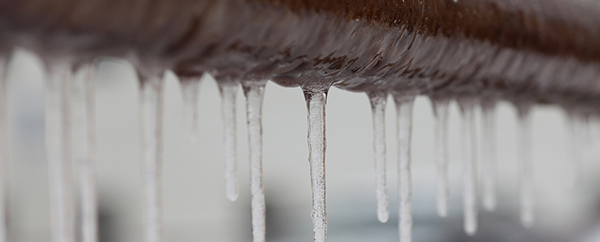Prevent Costly Winter Freeze-Ups in Your Building Pipes
- Learn what winter freeze-ups are and how to know if one’s occurred.
- View pre-season preparation steps to help prevent freeze-ups
- Here are steps to take if your building will be vacant over the holidays.
As temperatures drop and winter sets in, the risk of winter freeze-ups in building pipes becomes a real threat. Whether it’s automatic sprinkler system pipes for fire protection, steam condensate returns or domestic plumbing, insufficient building heat can burst pipes and cause water damage to the building and its contents. If a fire occurs while sprinklers are nonfunctioning, loss to your property and inventory can be even greater. Incorporate these steps in your risk management program to help prevent or mitigate winter damage.
How to determine if a freeze-up has occurred
If frozen pipes occur in domestic plumbing, the tell-tale sign is loss of water pressure or flow in spigots. However, if the freeze-up occurs in a fire protection system, it’s not so easy to spot. Because water expands when it freezes, it causes additional strain on pipes that can cause fractures or breaks in pipes, valves and fittings. When the water thaws, it escapes from fissures or other forced openings, causing property damage, business interruption and unhappy customers. In risk management, the best defense is a great offense. Take steps now to prevent freezing and bursting pipes.
Related: How to prepare your small business for winter
Pre-season preparations to prevent winter freeze-ups
Before winter sets in, arrange for inspection and maintenance of:
- The building’s heating system (an annual check)
- Air handling units: Ensure dampers are working and fans are controlled by thermostat for automatic shutdown when freezing temperatures occur
- Fire alarm systems: Check building low temperature and sprinkler system air pressure supervisory devices
- Non-freeze fire protection systems: Check air sources, air pressure levels, antifreeze solution and low point drains
- Wherever sprinkler piping is installed, such as in attics, ceiling spaces and stairwells, be sure that adequate heat is provided; install thermometers or remote-reading thermometers to help simplify ongoing inspections throughout winter
- Building exterior: check doors and windows for and repair any cracks or openings where frigid outside air leaks in
- Areas protected by wet pipe systems should be kept above 40 degrees Fahrenheit
- Ensure fire pumps are also in heated rooms; test at period intervals
- Check gravity tanks for leaks and overflows periodically
Related: Winter weather preparation tips
Periodic cold weather inspections help prevent winter freeze-ups
Once winter has arrived, begin periodic inspections using a checklist so as not to accidentally overlook any risk. The checklist should include:
- Building doors, windows and walls: Closed and weather tight
- Area temperatures within the building: Within acceptable ranges
- Heating system: Functioning properly
- Air pressure in each dry-pipe or pre-action sprinkler system: Within acceptable ranges
- Dry-pipe system low point drains: No water accumulation
- Water-filled pipes: Insulation is intact and heat tracing systems are functioning
Special circumstances for winter loss control
When a building will be vacant. If the building is typically unoccupied on weekends or holidays, the potential for a freeze-up is strengthened. It’s important to add periodic inspections to your risk management plan, particularly just before these unoccupied periods, to be aware of any forecast cold fronts that will occur during that time, and to have knowledgeable employees able to respond promptly, should the need occur.
When extreme cold is predicted. When extreme cold is forecast is the ideal time to perform a cold weather inspection. Consider increasing building heat to all areas. You may also want to override energy-saving set-back thermostats or building management programs that may automatically reduce building temperatures. Planning and prevention are the most effective means to address potential risks to your property assets from pipe freeze-ups. Implement a winter risk plan now that includes preseason preparations, periodic cold weather inspections, steps to mitigate any discovered freeze-ups and emergency contacts.
This blogpost originally appeared in Arrowhead’s Tribal blog. It has been modified and updated to better fit the needs of our Core Commercial agents and their clients.

